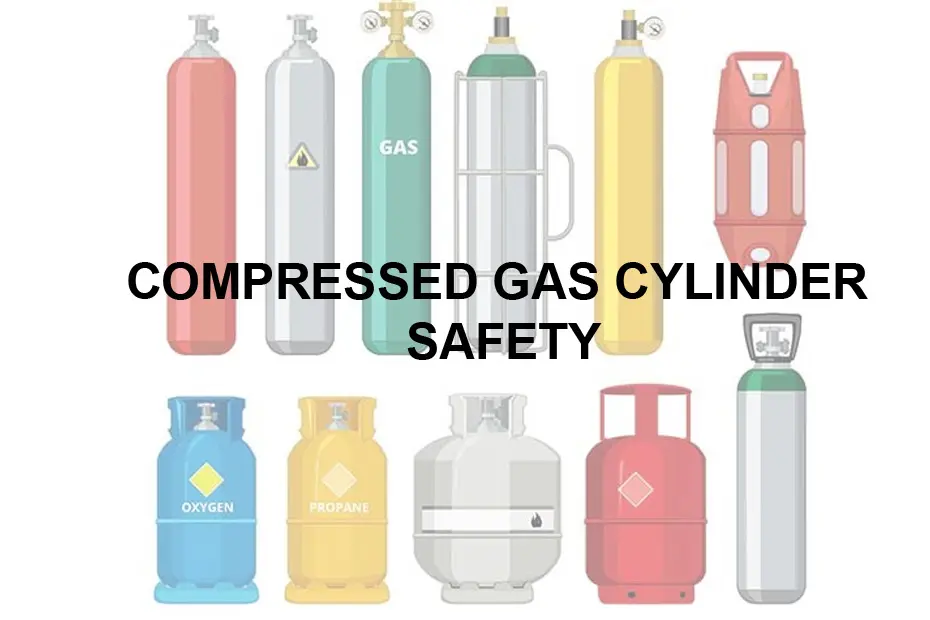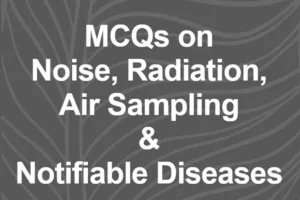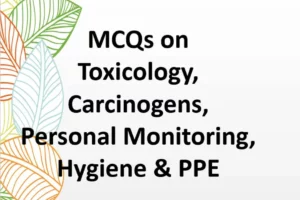Introduction
A compressed gas cylinder is like a sleeping giant.
It is heavy, smooth, and hard to grip securely.
It can be up to 57 inches tall, may weight up to 155 lbs full and be pressurized up to 2,200 psi.
Many industrial and laboratory operations require the use of compressed gases for a variety of different operations.
- Flammable or combustible
- Explosive
- Corrosive
- Poisonous
- Inert
- or a combination of hazards
If the gas is flammable, flash points lower than room temperature compounded by high rates of diffusion present a danger of fire or explosion.
Additional hazards of reactivity and toxicity of the gas, as well as asphyxiation, can be caused by high concentrations of even “harmless” gases such as nitrogen.
Since the gases are contained in heavy, highly pressurized metal containers, the large amount of potential energy resulting from compression of the gas makes the cylinder a potential rocket or fragmentation bomb.
Careful procedures are necessary for handling the various compressed gases, the cylinders containing the compressed gases, regulators or valves used to control gas flow, and the piping used to confine gases during flow.
Identification
The contents of any compressed gas cylinder must be clearly identified. Such identification should be stenciled or stamped on the cylinder or a label. Commercially available three-part tag systems may also be used for identification and inventory.
No compressed gas cylinder should be accepted for use that does not legibly identify its contents by name. If the labeling on a cylinder becomes unclear or an attached tag is defaced to the point the contents cannot be identified, the cylinder should be marked “contents unknown” and returned directly to the manufacturer.
Never rely on the color of the cylinder for identification. Color coding is not reliable because cylinder colors may vary with the supplier. Additionally, labels on caps have little value because caps are interchangeable.
Always read the label!
All gas lines leading from a compressed gas supply should be clearly labeled to identify the gas, the laboratory or area served, and the relevant emergency telephone numbers.
The labels should be color coded to distinguish hazardous gases (such as flammable, toxic, or corrosive substances) (e.g., a yellow background and black letters).
Signs should be conspicuously posted in areas where flammable compressed gases are stored, identifying the substances and appropriate precautions (e.g., HYDROGEN – FLAMMABLE GAS – NO SMOKING – NO OPEN FLAMES).
Handling & Use
Gas cylinders must be secured at all times to prevent tipping.
Cylinders may be attached to a bench top, individually to the wall, placed in a holding cage, or have a non-tip base attached. Chains or sturdy straps may be used to secure them.
If a leaking cylinder is discovered, move it to a safe place (if it is safe to do so) and inform the Environmental Health & Safety Department. You should also call the vendor as soon as possible.
Under no circumstances should any attempt be made to repair a cylinder or valve.
Standard cylinder-valve outlet connections have been devised by the Compressed Gas Association (CGA) to prevent mixing of incompatible gases.
The outlet threads used vary in diameter; some are internal, some are external; some are right-handed, some are left-handed.
In general, right-handed threads are used for non-fuel and water-pumped gases, while left-handed threads are used for fuel and oil-pump gases.
To minimize undesirable connections, only CGA standard combinations of valves and fittings should be used in compressed gas installations; the assembly of miscellaneous parts should be avoided.
The threads on cylinder valves, regulators and other fittings should be examined to ensure they correspond and are undamaged.
Cylinders should be placed with the valve accessible at all times. The main cylinder valve should be closed as soon as it is no longer necessary that it be open (i.e., it should never be left open when the equipment is unattended or not operating).
This is necessary not only for safety when the cylinder is under pressure, but also to prevent the corrosion and contamination resulting from diffusion of air and moisture into the cylinder after it has been emptied.
Cylinders are equipped with either a hand wheel or stem valve. For cylinders equipped with a stem valve, the valve spindle key should remain on the stem while the cylinder is in service.
Only wrenches or tools provided by the cylinder supplier should be used to open or close a valve. At no time should pliers be used to open a cylinder valve.
Some valves may require washers; this should be checked before the regulator is fitted.
Cylinder valves should be opened slowly. Oxygen cylinder valves should be opened all the way.
Open up the oxygen cylinder valve stem just a crack. Once the needle on the high pressure gauge has stopped, open up the valve all the way. This back-seats the valve.
Oxygen cylinders must have the valve opened up all the way because of the high pressure in the cylinder. There is a back-seating valve on the oxygen cylinder. This prevents the high-pressure gas from leaking out through the threaded stem.
When opening the valve on a cylinder containing an irritating or toxic gas, the user should position the cylinder with the valve pointing away from them and warn those working nearby.
Cylinders containing flammable gases such as hydrogen or acetylene must not be stored in close proximity to open flames, areas where electrical sparks are generated, or where other sources of ignition may be present.
Cylinders containing acetylene shall never be stored on their side.
An open flame shall never be used to detect leaks of flammable gases. Hydrogen flame is invisible, so “feel” for heat.
One common practice is to use a natural bristle broom to “sweep” the air in front of you.
All cylinders containing flammable gases should be stored in a well-ventilated area.
Oxygen cylinders, full or empty, shall not be stored in the same vicinity as flammable gases.
The proper storage for oxygen cylinders requires that a minimum of 20 feet be maintained between flammable gas cylinders and oxygen cylinders or the storage areas be separated, at a minimum, by a fire wall five feet high with a fire rating of 0.5 hours.
Greasy and oily materials shall never be stored around oxygen; nor should oil or grease be applied to fittings.
Regulators are gas specific and not necessarily interchangeable!
Always make sure that the regulator and valve fittings are compatible.
After the regulator is attached, the cylinder valve should be opened just enough to indicate pressure on the regulator gauge (no more than one full turn) and all the connections checked with a soap solution for leaks.
Never use oil or grease on the regulator of a cylinder valve.
If there is any question as to the suitability of a regulator for a particular gas, check with the Environmental Health & Safety Department or call your vendor for advice
The following rules should always be followed in regards to piping:
- Plastic piping shall not be used for any portion of a high pressure system.
- Do not use cast iron pipe for chlorine.
- Do not conceal distribution lines where a high concentration of a leaking hazardous gas can build up and cause an accident.
- Copper piping shall not be used for acetylene.
- Distribution lines and their outlets should be clearly labeled as to the type of gas contained.
- Piping systems should be inspected for leaks on a regular basis.
- Special attention should be given to fittings as well as possible cracks that may have developed.
A cylinder should never be emptied to a pressure lower than 172 kPa (25 psi/in2) (the residual contents may become contaminated if the valve is left open).
When work involving a compressed gas is completed, the cylinder must be turned off, and if possible, the lines bled.
When the cylinder needs to be removed or is empty, all valves shall be closed, the system bled, and the regulator removed.
The valve cap shall be replaced, the cylinder clearly marked as “empty,” and returned to a storage area for pickup by the supplier.
Empty and full cylinders should be stored in separate areas
Where the possibility of flow reversal exists, the cylinder discharge lines should be equipped with approved check valves to prevent inadvertent contamination of cylinders connected to a closed system.
“Sucking back” is particularly troublesome where gases are used as reactants in a closed system.
A cylinder in such a system should be shut off and removed from the system when the pressure remaining in the cylinder is at least 172 kPa (25 psi/in2).
If there is a possibility that the container has been contaminated, it should be so labeled and returned to the supplier.
Liquid bulk cylinders may be used in laboratories where a high volume of gas is needed.
These cylinders usually have a number of valves on the top of the cylinder.
All valves should be clearly marked as to their function.
These cylinders will also vent their contents when a preset internal pressure is reached, therefore, they should be stored or placed in service where there is adequate ventilation.
Always use safety glasses (preferably with a face shield) when handling and using compressed gases, especially when connecting and disconnecting compressed gas regulators and lines.
All compressed gas cylinders, including lecture-size cylinders, must be returned to the supplier when empty or no longer in use.
The cylinders that contain compressed gases are primarily shipping containers and should not be subjected to rough handling or abuse.
- Such misuse can seriously weaken the cylinder and render it unfit for further use or tTo protect the valve during transportation, the cover cap should be screwed on hand tight and remain on until the cylinder is in place and ready for use.
- Cylinders should never be rolled or dragged.
- When moving large cylinders, they should be strapped to a properly designed wheeled cart to ensure stability.
- Only one cylinder should be handled (moved) at a time.
transform it into a rocket having sufficient thrust to drive it through masonry walls.
- To protect the valve during transportation, the cover cap should be screwed on hand tight and remain on until the cylinder is in place and ready for use.
- Cylinders should never be rolled or dragged.
- When moving large cylinders, they should be strapped to a properly designed wheeled cart to ensure stability.
Only one cylinder should be handled (moved) at a time.
Hazards of Compressed Gas Cylinders
The effects of unintentional release of energy by a compressed gas cylinder can have devastating results. Over 150 pounds of steel, traveling at high speed, can cause severe damage,
personal injury and even death.
Compressed gas cylinders present both mechanical and chemical hazards in the work place.
Physical Hazards:
- Tip over
- Explosion
- Uncontrolled projectile
Chemical Hazards
- Asphyxiation
- Poisoning
- Anaesthetic effects
- Tissue Damage
Why These Guidelines Are Vital To Your Safety
Injuries you can avoid. The injuries that can occur are as varied as the situations causing them. Some of these injuries include:
- Severe cuts, bruises, and burns
- Broken bones and loss of limbs
- Spinal cord injuries
- Asphyxiation
- Poisoning
- Death
Components of a Compressed Gas Cylinder
- Cylinder Cap
- Valve Handwheel
- Valve Outlet Connection
- Valve Pack Nut
- Pressure relief valve
- Valve Outlet Cap
- Cylinder Collar
- DOT/Cylinder type & PSI rating
- Cylinder serial number
- Initial hydrostatic test date
- First 5 year hydrostatic retest
- “ë” qualifies for 10 year retest
- Original inspectors insignia
Safe Practices for Handling & Use
Some gases have very specific procedures for safe use. Before handling any compressed gas cylinder, locate the Material Safety Data Sheet, or MSDS, for the gas you are using. This document contains vital information for handling each gas.
- Do not rely on cylinder colour
- The cylinder should be clearly stencilled or stamped
- The identification label should be permanently attached to the cylinder
If in doubt do not use the cylinder!
If a valve is improperly removed, the compressed gas inside the cylinder can be released unexpectedly. If the cylinder falls and the valve is damaged the cylinder can become an uncontrolled projectile. To avoid this hazard, secure the cylinder at all times with an appropriate two-point restraint device/system.
Chains are the best recommendation. Straps and table clamps often fail due to improper use and set-up. Clamps are generally not kept tight and placed on articles that are not secure (movable desks tables, etc.). Straps are often buckled incorrectly thus providing no restraint. Fasten restraints on the upper half of the cylinder, above the centre of gravity (e.g., just below the top), and at the bottom ~8-12 inches from the ground.
There are a number of different types of cylinder valves affixed to cylinders. Standard cylinder-valve outlet connections developed by the Compressed Gas Association (CGA) are configured differently for each family of gases to minimize the potential of mixing incompatible gases. CGA connections typically utilize a three-digit coded number. This code generally includes:
Outside diameter of valve threads
- Threads per inch and thread size
- Left-hand thread or right-hand threads
- External or internal threads

Regulator Operation:
- Attach the regulator to the cylinder valve outlet.
- Turn the delivery pressure adjustment knob counterclockwise until it turns freely.
- Ensure the flow control valve is in the closed position.
- Slowly open the cylinder valve until the regulator registers the cylinder pressure.
- Turn the delivery pressure adjustment knob clockwise until the desired delivery pressure is reached.
Be certain that the tubing used to convey the gas from the regulator to its end use is compatible with the gas.
Example: Copper tubing + acetylene =copper acetylide (explosive)
Gas Cylinder Operation
Opening cylinders
- Place the cylinder in an upright position so the
- valve is always within reach.
- Check fume hood or ventilation.
- Warn co-workers that you are about to open the valve and position the cylinder with the valve pointing away from you.
- Be sure fittings are clean, dry, and free of oil or grease.
- Be sure the threads on the regulator correspond with those on the cylinder valve outlet.
- Use regulators and pressure gauges only with gases for which they are designed.
- Open the valve slowly and close the valve immediately when finished.
Closing cylinders
- Close the cylinder valve completely.
- Bleed the lines if possible.
- Tighten the flow control valve on the regulator or remove it if the cylinder is empty.
- Replace the safety cap.
Liquefied Gas Cylinder Operation
A liquefied compressed gas can be defined as a gas, which when compressed in a container, becomes a liquid at ordinary temperatures and at pressures ranging from 25 to 2500 psig. Liquefied gases have boiling points that range from –130 to 30°F (–90 to –1°C). At 70°F (21.1ºC) the cylinder contains both liquid and gas. Cylinder pressure, or the “vapor pressure” of the gas, is directly affected by ambient temperatures.
Regularly inspect cylinders.
Take a few extra minutes to inspect the compressed gas cylinder. It could save you and your co-workers serious injury
Ask these questions
- Does the cylinder have signs of defects?
- Does it show signs of deep rusting?
- Does it contain the correct gas in the designated usage area?
- Return any cylinders with problems (e.g., cap rusted shut, etc.) to the supplier
Inspecting & Testing Compressed Gas Cylinders
You should also inspect the cylinders hydrostatic test dates. Most cylinders in use should be retested every 5 years unless marked with a “”
which indicates the cylinder qualifies for a 10 year retest interval.
For cylinders containing flammable or combustible gases, use an approved flammable gas detector. Test systems that carry toxic or corrosive gases with inert gas before operating. After you complete the tests, place a tag on the regulator with your name and test date.
Safely Store Compressed Gas Cylinders
Store cylinders in the right environment. Storage space and floor should be:
- well ventilated
- free of flame, sparks, or electrical circuit
- level, fireproof, and dry
- below 125 degrees Fahrenheit
- out of the sun’s direct rays if in an extreme climate
- Segregate cylinders by hazardous gases.
- Incompatible gases must be stored by hazard
- class in separate areas, even when the cylinder
- is empty. Separate the incompatible cylinders by:
- a distance of at least 20 feet, or
- a five foot firewall with a fire rating of 1/2 hour
Safely Transport Compressed Gas Cylinders:
Many accidents occur while moving or transporting cylinders. Handle cylinders gently. They may look strong and solid, but if a cylinder is damaged it can become an uncontrolled projectile damaging anyone or anything in its path.
Whether you move cylinders short or long distances, follow these guidelines:
- Remove the regulator. Never move a cylinder with the regulator still in place.
- Replace the valve protection cap. Never lift a cylinder by the valve or protective cap.
- Secure the cylinder to a suitable hand truck or cart in an upright position.
- Take precautions so cylinders will not fall or strike each other or any other surface.
- Never roll, drag, or slide the cylinder.
Best Safety Practices
- Always read the MSDS before working with a compressed gas.
- Positively identify the gas you are working with.
- Always go through the inspection checklist.
- Be sure the work area is well ventilated.
- Know the emergency procedures for the particular gas being used and the location of the emergency equipment.
- Wear appropriate personal protective equipmen




